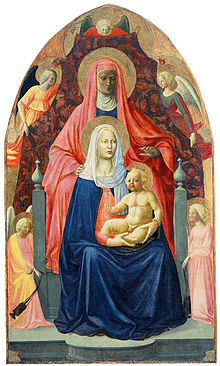Masolino da Panicale
Masolino | |
|---|---|
Pipo of Ozora Cardinal Branda Castiglione |
Masolino da Panicale (nickname of Tommaso di Cristoforo Fini; c. 1383 – c. 1447) was an
Biography
Masolino ("Little Tom") was possibly born in Panicale near Florence.
Early use of the central vanishing point
Masolino was probably the first painter to make use of a central vanishing point in his 1423 painting St. Peter Healing a Cripple and the Raising of Tabitha.[6]
St Catherine Refusing to Worship Idols
"The lunette of the left-hand wall, depicting St Catherine Refusing to Worship Idols. In an elaborate temple setting, Catherine is pointing toward heaven, while the emperor, here bareheaded, gazes up at the idolatrous statue atop the altar. His retainers are crowded behind them, one of them, only partially visible, is sounding a trumpet."[7]
Summary of work
- Section includes external links to works of art.



Complete works
In Naples:
- Miracle of the Snow, triptych, commissioned by Basilica of St Mary Major, ca. 1423, National Museum and Gallery of Capodimonte.
In Germany:
- Madonna and Child, tempera on wood, Alte Pinakothek.
- Madonna and Child (1423), tempera on panel in Kunsthalle Bremen.
In Florence:
- Cappella Brancacci: cycle of frescoes in collaboration with Masaccio, 1424.
- Madonna and Child, Saint Anne and the Angels, collaboration with Masaccio, tempera on wood, 1424, Uffizi, Florence.
- Madonna dell'Umiltà, tempera on wood, 1430–35, Uffizi.
In Empoli:
- Cristo in Pietà, detached fresco, 1424, Empoli, museum of the Collegiata di Sant'Andrea.
- Saint Ivo and the Pupils, fresco, 1424, Empoli, Church of Saint Steven.
- Virgin and Child, fresco, 1424, Empoli, Church of Saint Steven.
In Rome:
- Fresco of the Life of St Catherine of Alexandria commissioned by Basilica di San Clemente, Chapel of Sacrament, 1428.
- Fresco of the Annunciation in the Basilica di San Clemente, Chapel of Sacrament, 1428.
- Fresco of St Christopher in the Basilica di San Clemente, Chapel of Sacrament, 1428.
- Death of the Virgin and Crucifixion, fresco, Pinacoteca Vaticana.
In Castiglione Olona, where his patron was cardinal Branda da Castiglione:
- Hungarian Landscape in the Palazzo Branda Castiglione.
- Story of the Virgin (1435) in the Collegiata.
- St. John the Baptist (1435) in the Baptistery of Castiglione Olona.
In France:
- Scenes from the Legend of Saint Julian the Hospitaller, tempera on wood, 21 x 39 cm, Musée Ingres.
In the United States:
- Annunciation (1425–1430) oil and tempera on wood 148 x 115 cm, National Gallery of Art, Washington, D.C.
- The Archangel Gabriel and The Virgin Annunciate, both ca. 1430, tempera (?) on panel, National Gallery of Art.
Dispersed pieces of works
- Lateral panels of an altarpiece with The Ascension at the center, from National Gallery, London; The Ascension[permanent dead link] National Museum and Gallery of Capodimonte, Naples.
References
- ^ a b His birthplace is unresolved. Possibilities include Panicale in Val d'Elsa (vgl. Vasari, Enciclopedie on line, Catholic Encyclopedia and arte.it) or Panicale ai Renacci near San Giovanni Valdarno (see Masolino da Panicale. In: Ulrich Thieme, Felix Becker etc.: Allgemeines Lexikon der Bildenden Künstler von der Antike bis zur Gegenwart. Band 24, E. A. Seemann, Leipzig 1930, pages 210–211, National Gallery of Art) and zeno.org He may have beenFlorenceEB1911|wstitle=Masolino Da Panicale |volume= |short= x }}
- ^ "Masolino da Panicale (1383 - 1447)". Alte Pinakothek. Archived from the original on 2011-06-06. Retrieved 2009-01-28.
- ^ "Darkness and Depth in Early Renaissance Painting" (PDF). Retrieved 2021-12-09.
- ^ Mode, Robert L. (1972). "Masolino, Uccello and the Orsini 'Uomini Famosi'". The Burlington Magazine. pp. 368–378.
- ISBN 0-500-23677-1.
- ^ "Perspective: The Rise of Renaissance Perspective".
- ^ Web Gallery of Art - Fresco
External links
- Masolino da Panicale at Panopticon Virtual Art Gallery
- Masolino da Panicale on Artcyclopedia
- Herbermann, Charles, ed. (1913). . Catholic Encyclopedia. New York: Robert Appleton Company.
- "Masolino da Panicale (1383 - 1447)". Alte Pinakothek. Archived from the original on 2014-03-18. Retrieved 2014-03-11.
- Rossetti, William Michael (1911). . Encyclopædia Britannica. Vol. 17 (11th ed.). p. 838.
- Carl Brandon Strehlke, "Saints Paul and Peter, and Saints John the Evangelist and Martin of Tours by Masolino da Panicale (inv. 408, 409)[permanent dead link]" in The John G. Johnson Collection: A History and Selected Works[permanent dead link], a Philadelphia Museum of Art free digital publication.
